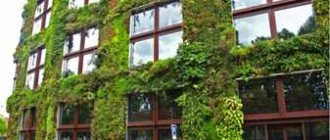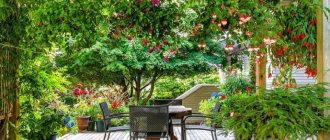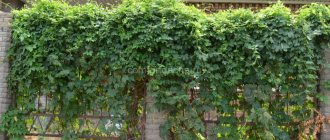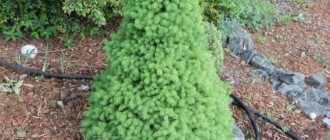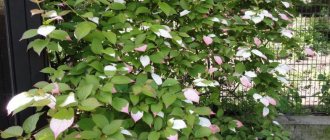Owners of suburban areas and summer residents in the spring are concerned not only with planting, but also with how to effectively decorate their site. One of the decoration elements is a fence. To create a laconic fence, various plants are often used. It is best to choose fast-growing ones in order to admire a neat hedge after a short period of time. Today we will talk about such plant varieties.
Features of selection and planting
Climbing plants are perfect for decorating wooden, metal, and even plastic fences. In addition to the decorative component, decorating with flowers will not require significant financial investments. The climbing plants themselves will add originality to the site; you don’t even need the work of a designer.
To select a specific plant for collection, you will need to decide on the following criteria:
- climate features of the area;
- desired regime of plant care;
- the appearance of the plant itself and the fence after decoration.
You should definitely take into account the above criteria, since there are currently many types of fast-growing climbing plants for fences, including both perennial and annual representatives and even weeds.
Any climbing plant for a fence requires careful care. So, in order for the fence to please with its splendor and beauty, it is necessary to properly plant the seedlings, and then provide proper care for them.
For successful rooting of seedlings, the best time for planting is spring or autumn. It is worth noting that when purchasing seedlings, you need to choose only those that are equipped with containers with soil. Those plants that have been left without soil for a long time can quickly die.
The first year for any planted plant is the most difficult. It is necessary to carefully monitor and care for the seedling. On hot days, such climbing plants are protected from constant exposure to the sun and watered abundantly, and on frosty days they are wrapped. If everything goes correctly, then in the second year the plants will be fully adapted to the environment and will be able to delight with their beauty.
Advice! As a fertilizer, professionals advise choosing organic matter. At home, this role can be played by a small fatty fish, which needs to be buried at the bottom of the plant hole. The nutrients released during the decomposition process will be sufficient for the seedling to last for a long time.
During planting and after it, it is necessary to thoroughly water the seedling for a week, since even slight drying out can cause the death of young roots. When planting fast-growing climbing plants along the fence, keep a distance of half a meter between shoots.
At the moment there are a large number of climbing plants that differ in some characteristics depending on the variety. So, there are loaches:
- perennial and annual;
- flowering and having decorative foliage;
- evergreen and deciduous;
- with and without thorns;
- shade-loving and sun-loving.
Fast-growing climbing plants can create a decorative effect on a hedge in just 2 years, so before planting it is necessary to update the fence or repair it, since this will simply be impossible to do later.
What do you usually plant?
Landscaping along the fence consists of using one or more types of seedlings. They are usually divided by height: low flowers, medium shrubs or tall trees. The first ones perform rather a decorative function. The latter create shade and protect from noise and dust from the road.
Shrubs
Their main advantage is their low height. While trees in a circle can create the feeling of a small enclosed space, this will not happen with bushes.
You can plant perennial shrubs along the fence in both large and small areas. They can be:
- deciduous - turf, euonymus, cotoneaster, boxwood;
- fruit - raspberries, currants, felt cherries, honeysuckle, barberry, rose hips, serviceberry, hawthorn - a harvest of delicious fruits is an excellent reward for your work;
- blooming - lilac, azalea, buddleia, weigela, hydrangea, rhododendron.
The photo shows trimmed bushes in one row
Many bushes can be trimmed, giving them fancy shapes - if you learn how to trim yourself or periodically invite a specialist, green shapes can become a feature of your garden.
Flowers
In the previous section, we already mentioned that shrubs can flower. But flowers along the fence can be even lower and more compact. When choosing suitable varieties, take into account the height of the adult plant and the flowering period. To make the flower garden look decorative all season long, plants of different sizes and different seasons are planted together.
The most popular flower crops:
- Rose. Climbing varieties curl beautifully over a mesh (if the fence is made of chain-link), and they decorate gates and canopies.
- Wisteria. A powerful vine with beautiful buds. Usually planted under strong fences made of brick and stone.
- Dahlia. Low bushes with large flowers are a decoration for any garden.
- Peony. Lush, fragrant, tight peonies bloom in early summer, when other plants are just gaining color.
- Gladiolus. Beloved by many since school days, they look beautiful in a row.
In the photo there are wildflowers near the picket fence
If you want to achieve the effect of slight chaos and not spend a lot of time caring for the flowerbed, plant cosmos, white chamomile, cornflowers, poppies, lavender, and petunia.
Trees
In the garden, it is logical to plant fruit and berry trees along the fence: apple trees, pears, plums, cherries, chokeberries, apricots. Although they require special care, every summer and autumn they will delight you with fresh fruits and berries.
Both compact fruit varieties and tall decorative deciduous varieties are planted near the fence of a private house. These can be blue or regular spruce, pine, aspen, oak, chestnut, maple. Poplars and birches are highly allergenic, so it is better not to use them in close proximity to residential premises. What you need to consider when planting trees along a fence:
- Growth prospects. Consider how tall and wide the mature tree will be and think in advance - will it block important areas from the sun?
- Root system. It will grow as it matures and can break the fence - so move the seedling 3-5 m from the edge.
Coniferous trees (spruce, thuja, cedar) purify the air well, and thanks to the preservation of needles, your property will be hidden from prying eyes all year round.
If you plant deciduous trees (aspen, linden, etc.) near the fence, you will be able to observe the beauty of nature - in the summer the area will be green, in the fall the trees will flash yellow and red, in the spring the buds will begin to awaken and new leaves will appear.
In the photo there are identical thujas in a row
Mixborder
Planting flowers, trees and shrubs along the fence means creating a mixborder on your site. This composition can be collected from absolutely any species: annual and perennial, large and short, flowering, berry and ornamental. When planting such a mix, arrange it so that the flowerbed looks aesthetically pleasing from May until October - first some bloom, then others.
Try to arrange the seedlings according to the principle of a ladder, paying attention to the size of the grown and not the young seedling.
- On the first line there is low grass and flowers. Usually these are early flowering tulips, daffodils, and lilies of the valley.
- In the center are medium-sized bushes blooming in June-July - lilies and peonies.
- Behind are tall trees and shrubs, preferably late flowering or with bright (yellow, red) leaves.
In the photo there is a mixborder with various plants
climbing perennials
Most gardeners choose perennials to decorate their fences, as this allows them to avoid planting new plants every year. Their feature is powerful stems, which create a significant load on the fence, so the support must be strong enough. Often perennial climbing plants delight not only with their magnificent appearance, but also with edible berries. Among such varieties for fences are honeysuckle, actinidia and nightshade.
Before buying a plant, you should think carefully about what you want to see on the fence in the end, since perennials can be flowering and have only decorative foliage with barely noticeable inflorescences.
Fast-growing perennials are distinguished by the way they are fixed to the surface:
- Climbing - entwining vertical supports, as well as tree trunks and shrubs.
- Climbing, with small roots that penetrate inside the entire surface of the support. Moreover, this happens even with brick, stone and wooden fences.
- Clinging, using various processes and antennae to hold. Such plants grow well on mesh fences.
- Supporting - loaches that require vertical supports.
Clematis
Another variety of perennial vines for a fence. Bushes are planted in autumn. The plant does not require constant watering, fertilizer, etc.
Adviсe! When it is very hot outside, it is recommended to sprinkle the roots with humus to protect them from the scorching sun.
Clematis pleases with bright green and reddish leaves in large quantities. Flowering begins in early summer and ends with the first frost. Clematis can go well with other varieties of loach.
Popular flowering perennial vines
Perennials, in essence, are unpretentious plants that are suitable for planting along the fence by those owners who do not have the opportunity to provide constant proper care. Even without it, varieties of these plants entwine the fence every year more and more. In addition, such climbing shoots are mostly resistant to harsh climates and easily adapt to them.
Actinidia
A significant advantage of actinidia is the fact that it is not a parasitic plant, since it does not dig into the base with its roots and does not damage the trunks of shrubs and trees.
Due to the presence of fruits, actinidia acts not only as a decorative decoration for a fence. Its fruits can be eaten and even preserved for future use. They contain a large number of nutrients and minerals important for the human body. Already in the third year of growth, this fast-growing climbing plant begins to bear fruit. This vine is long-lived and can bear fruit for up to 50 years.
Actinidia is a plant that is resistant to harsh climates, but prefers illuminated places, since only there it can fully bear fruit. Since the plant's roots do not go deep into the soil, they dry out quickly, so abundant regular watering is important.
Important! Requires planting of male and female shoots.
Bougainvillea
This climbing perennial came to us from Brazil and is distinguished by a huge number of varieties. The plant can be shaped as a bonsai.
This plant loves the sun and dies at temperatures below 5 degrees, so in the fall the vine is removed to a warm room for the winter. The loach must be watered regularly, but in cool times the water supply is reduced to a minimum.
Bougainvillea would not be a good choice for decorating a fence as a climbing vine. But you can place tubs with this plant near it to create something like a living fence.
Honeysuckle
This fast-growing climbing plant has a large number of varieties, many of which are poisonous, so you should be careful when choosing for your fence. Thanks to its gorgeous flowering, it is chosen by many summer residents to decorate their fences, and its wonderful aroma creates a romantic atmosphere in the area.
This climbing plant is resistant to the climate of the middle zone and tolerates frost well. It grows in both sun and partial shade, but in the latter case the flowering is less abundant.
Important! The support for honeysuckle must be strong and stable in order to withstand considerable weight.
For greater decorativeness and pollination efficiency, experienced gardeners advise planting different types of honeysuckle along the fence together.
Winter-hardy
The evergreen climbing perennials from the first section survive even harsh winters without loss, but there are other options.
Honeysuckle
Ornamental species, such as honeysuckle, climb beautifully and bloom profusely throughout the season. But they have a drawback: the berries of these varieties (unlike shrubs) cannot be eaten, they are poisonous - so you should not plant them in an area where children can reach the fruits. Mature plants tolerate frosts without problems; they are not even removed from their supports. Young ones (up to 2-3 years) are best removed and covered at the end of the season.
Honeysuckle loves moist soil, so it is better to mulch the surface after planting to retain moisture. It grows best in the sun; the darker it is, the slower it will develop and bloom less.
Woodplier
As the name implies, this vine has more than enough strength and desire to live: without control, it will quickly kill other plants from the area and take over the territory. But with timely pruning, a hedge, even based on a picket fence or chain-link mesh, looks very decorative.
The tree plier survives the winter without much loss; you should not worry even if some of the shoots freeze. Thanks to its powerful root system, it will quickly recover with the arrival of warmer weather.
In the photo there is a wood plier entwined around an arch
Chinese lemongrass
This type of hedge has nothing to do with citrus fruits; the name was given solely because of the pleasant aroma of the fruit. Schisandra takes root and winters even in Siberian and Far Eastern territories, not to mention the mild winters of the central part of Russia. The only thing to keep in mind is that it does not like the sun, but it is ideal for decorating the shaded side of the fence.
Important! Schisandra stems are dried and brewed as tea - this drink has a restorative, energetic effect. Increases blood pressure, can even replace coffee.
Decorative leafy perennial vines
Flowering varieties of climbing plants undoubtedly decorate the fence effectively, but vines with decorative foliage also look stunning.
Amur grapes
This plant can tightly weave a fence so that a hedge is formed. This grape variety can withstand frosts down to -45 degrees Celsius. It develops equally well both in partial shade and in open areas.
This fast-growing climbing plant requires constant watering and fertilizing the soil with mineral components. Since Amur grapes prefer loose soils, it is necessary to carry out such treatment in a timely manner.
Advice! Young shoots, leaves and fruits of grapes can be eaten.
Maiden grapes
This is a powerful plant that can have shoots up to 20 meters in length. It is quite resistant to frosty winters and harsh climates. A special feature is the change in foliage color in the autumn months from dark green to crimson red.
The plant can grow on any soil composition and requires regular watering and mulching of the soil in order to hide the emerging roots. The important thing is that this loach can be attached to any surface without the need to install trellises.
The berries of virgin grapes are inedible; they serve a decorative function after the leaves fall off. In winter, the fruits of the plant will become good food for birds.
Euonymus Tree-nose rotundifolia
This shrub has a spectacular appearance and can quickly weave around a fence or gazebo. The plant comes from the Far East, so it can easily withstand the harsh conditions of central Russia. Euonymus is completely undemanding and can grow on any soil, including rocky soil. Requires only pruning during growth.
Important! The variety is classified as medicinal and is used for problems with blood circulation, for the treatment of various types of wounds and ulcers.
In addition to the presented climbing perennials suitable for framing a fence, we can also highlight:
- Rowan-leaved Spiraea, capable of attracting the views of passers-by and guests with its spectacular appearance.
- A climbing rose that will become a real decoration of the entire area with proper care.
- Bryonia, which gives originality to the fence with its carved foliage.
- Chinese lemongrass is an ornamental vine that is not only beautiful in appearance, but also has useful fruits.
- Prince of Siberia, creating a semblance of a bright carpet on the fence.
Willow hedge
You can grow a very special green hedge from willow. It can be woven from freshly cut willow branches, which are simply buried in the ground. Such a landing is accepted with a very high probability. Branches can even be inserted at both ends, forming an arc. The willow will take root from both ends at once. To speed up the process, cut off the top of the shoot and cut the bark lengthwise in two places by a couple of centimeters. The prepared shoot is stuck into the ground in this way.
Willow hedge
Using this feature, you can weave a hedge that will turn green in a few weeks. The prepared shoots are buried 15 cm, the soil around is pressed tightly, and the planting is watered. To make everything look more attractive - the dried ends of the branches do not stick out - bend the rods. At intersections they can be intertwined or tied together. If the branches are too thin, you can use two twigs, and also periodically place supports that will hold the fence in place.
The disadvantage of such a hedge is that it only has a decorative appearance for a few years. Afterwards the shoots become woody and the greenery practically disappears. But this does not make the fence any less reliable. On the contrary, it is difficult to break through such a wall - the branches are tightly woven.
Annual climbing plants
Some summer residents who have the opportunity and time like to update the appearance of their site every year, so annual climbing plants are used to decorate fences.
Annual sweet pea
This climbing plant clings to support with the help of tendrils and has thin ribbed stems. Depending on the variety, the flowers of this loach have different colors. Often, sweet peas, in addition to fences on dacha lands, can even be seen on the balconies of city apartments.
Sweet peas are planted only in areas that are protected from strong winds, which can break the thin shoots of a climbing plant. Grows well in neutral soil, which is regularly supplemented with organic fertilizers. Nitrogen fertilizers are not suitable for this variety.
morning glory
This climbing, fast-growing plant delights gardeners with its uniquely beautiful flowering. Its inflorescences look like gramophones and have an enviable palette of shades depending on the variety, which will become the highlight of the fence.
Morning glory is planted in the spring as seedlings in sunny areas that are protected from drafts. In general, it does not require special care, but it develops best in rich organic soil near the fence.
Climbing Kobea
This unique loach can reach a height of 6 meters and decorate the fence with its spectacular blooms in the form of large bells. The soil for Kobei should be well drained. Planting is carried out in April - May in illuminated areas. Kobeya is resistant to pests and various diseases.
climbing nasturtium
This plant can be in the form of a bush or vine with bright orange flowers. The leaves of this loach are often eaten. It is preferable to plant nasturtium in open areas in fertile soil supplied with mineral fertilizers. There are many recommendations for caring for nasturtium; it is not always possible to grow a truly chic design for a fence.
Seedling annuals
Heat-loving species need to grow sprouts from seeds before planting in the ground. This way the flowering time is not delayed.
morning glory
They have heart-shaped leaves. The petals are large, in the core they have shades contrasting from the edges. A large number of stems and wide leaves form a dense curtain on strong structures.
Nasturtium
An undemanding plant, up to 3 meters high. The stems are branched, with lobed, shield-shaped leaves. The buds are collected from five petals of red or yellow color. Has nutritional value. There are almost 100 species. All parts of the plant are used to make medicinal recipes.
Kvamoklit
Liana with long shoots, up to 3 meters in size. The shape of the leaves resembles thin needles of coniferous trees. Buds of 5 petals, with sharp edges. Up to 2 cm in diameter. The shoots curl. The bolls ripen by autumn and are colored light brown.
Turkish beans
Plant up to 2.5 m long, with thin shoots. The leaves are collected from pointed leaflets, three to 30 cm long. They have a rich green color. Flowers give way to pods.
Suitable for decorating verandas and balconies. The petals are bright scarlet, there are white and pink flowers. In some countries it is grown for food. The pods have a partition, grow in the shape of a boat, and are bent downwards. The liana curls. Flowers do not emit a smell.
Beautiful plants are used in landscaping areas. Thanks to their flexibility and unpretentiousness, they allow you to create unique compositions every year.
Shade-loving loaches
Most fast-growing climbing plants for fences prefer a location in sunny areas. But what to do if the fence is located where the sun rarely hits during the day? In this case, you can suggest decorating the fence with evergreen ivy or hops.
The first is famous for its unique-looking foliage, which slightly resembles the leaves of a maple tree. They are painted green with white edges, which, if thick enough, looks very advantageous on the fence.
Hops have the appearance of a vine with leaves and cones, which allow it to be used as a decoration for a fence. In addition to beauty, hops also emit a pleasant aroma that envelops the entire area where it grows.
Kampsis
Also known as trumpet flower. It is a woody vine, the length of which can reach up to 16 meters. Young Campsis is rich in a large number of green leaves and bright orange or red flowers. It grows anywhere, but it is desirable that the soil is loose and fertile.
Planting is carried out after frosts in April. They are very easy to care for and do not require constant care and watering. They also need to be pruned every year. Removing old shoots will allow the plant to sprout new shoots. In severe frosts, the vine must be freed from its support and placed under the flooring.


